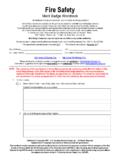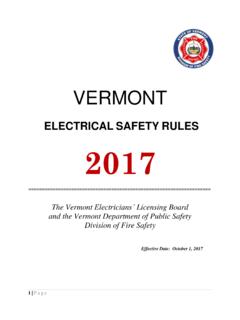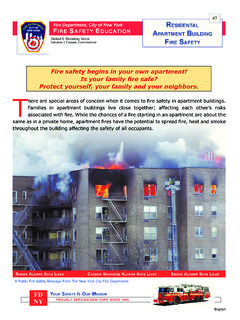Transcription of Fire Safety Lesson Plans for Grades PreK-8
1 1 fire Safety Lesson Plans for Grades PreK-8 585-383-6507 2 ACTIVITIES BY TOPIC AND grade LEVEL RANGE ..3 HOW DO WE USE fire ? ..4 SAFE FOR PLAY! KEEP AWAY! ..8 GO TO THE FIREFIGHTER ..9 fire PREVENTION IS EVERYONE S JOB .. 10 GET LOW AND GO .. 11 STOP! DROP! AND ROLL! .. 12 HELP MIKEY MAKE IT OUT .. 13 MIKEY MAKES A MESS .. 14 WHAT TO DO WHEN THE ALARM GOES OFF .. 15 home HAZARDS .. 17 KITCHEN Safety .. 18 CALLING 19 MICROWAVE Safety .. 20 WHICH WAY IS OUT? .. 21 SEARCH AND RESCUE .. 22 SCIENCE 1 -WHAT BURNS AND HOW .. 23 SCIENCE 2 - SMOKE .. 24 SCIENCE 3 - FLAMMABILITY .. 25 SCIENCE 4 - fire PREVENTION .. 26 COMMON CAUSES OF home FIRES .. 27 FIREFIGHTING AS A CAREER .. 34 We d like your feedback! Let us know how you ve used a Lesson plan , your students reactions, your comments and suggestions: 3 ACTIVITIES BY TOPIC AND grade LEVEL RANGE fire Prevention Emergency Preparedness Escaping a fire The Science of fire and Smoke Pre-K - grade 2 How Do We Use fire ?
2 Safe for Play! Keep Away! Mikey Makes a Mess How Do We Use fire ? Help Mikey Make It Out Calling 911 Go to the Firefighter Get Low and Go Stop! Drop! and Roll! How Do We Use fire ? Safe for Play! Keep Away! Grades 3-5 What to Do When the Alarm Goes Off home Hazards Kitchen Safety Microwave Safety Mikey Makes a Mess Firefighting as a Career fire Prevention Is Everyone s Job Which Way Is Out? Search and Rescue Calling 911 home Hazards Get Low and Go Microwave Safety Grades 6-8 What to Do When the Alarm Goes Off Science 1 -What burns and how Science 4 - fire Prevention Common Causes of home Fires Microwave Safety For Spanish classes: Mikey Makes a Mess available in Spanish For babysitting: Kitchen Safety Firefighting as a Career Science 2 - Smoke Science 3 - Flammability Science 1 -What burns and how Science 2 - Smoke Science 3 - Flammability Science 1 -What burns and how Science 2 - Smoke Science 4 - fire Prevention 4 HOW DO WE USE fire ?
3 grade level: PreK-5 Suggested Time: 20 minutes Overview Our homes have many sources of flame and heat. Children need to know which things are safe for them to use and which are tools for adults only. Objective Children and their parents are made more aware of the sources of fire and heat, and reminded of key Safety practices and the message that these are adult tools. Resources/Props/Preparation Worksheets following this Lesson plan , scissors, pencil The Lesson Note: Select from below the questions most appropriate for the age of the children 1. Have students cut out the sorting labels and the 16 pictures of sources of fire /heat. 2. Explain to students that they are going to sort the pictures into categories, and that it is okay if their answers are different, and that some pictures may not fit perfectly into a category.
4 3. Have students first sort the pictures by "Electricity" vs. " fire ." Ask questions like: How would electricity lead to a fire ? Which is more dangerous? Do you have more examples of electricity or fire in your home ? Have students compare sorts and discuss differences. Are there any examples that don't fit into either category? What could another category be? 4. Have students then sort the pictures by "I can use with help" vs. "Adults Only." Ask questions like: What sources of heat are you allowed to use at home ? What are the Safety rules for using those sources of heat? How would the sort change as you get older? Have students compare sorts and discuss differences. Are there any examples that don't fit into either category? What could another category be? 5.
5 Have students sort by the locations of the heat sources in their house. Ask questions like: What room has the most sources of fire or heat? What room do you think most fires start in? Have students compare sorts and discuss differences. Are there any examples that don't fit into either category? What could another category be? 6. Have students match the source of heat/ fire with the correct Safety tip. Answers: candle (h), stove (l), microwave (b), campfire (e), clothes dryer (k), matches/lighter (c), fireplace (g), hair dryer (j), oven (m), iron (a), tea kettle (f), toaster (i), lightbulb (d) 5 Electricity fire I can use with help Dangerous! Adults only! 6 Candle Stove Microwave Campfire Cigarette Clothes Dryer Dishwasher Matches Lighter Fireplace Hair Dryer Oven Iron Tea Kettle Toaster Lightbulb 7 Match the source of heat or fire with the correct Safety tip to prevent fires or burns!
6 _____ candle a. make sure the cord isn't cracked or damaged _____ stove b. never put metal in it _____ microwave c. don't use - get adult help! _____ campfire d. never put a blanket or clothing over it _____ clothes dryer e. keep a bucket of water next to it _____ matches/lighter f. don't hold the mug as you pour _____ fireplace g. clean the chimney once every year _____ hair dryer h. always blow it out before you leave the room _____ oven i. never stick a knife in it to get the food out _____ iron j. don't use near a sink or bathtub _____ tea kettle k. clean the lint trap after every load _____ toaster l. never leave the kitchen unattended if this is on _____ lightbulb m. don't put dish towels or pot holders in the drawer underneath 8 SAFE FOR PLAY! KEEP AWAY!
7 (Excerpted from the BIC play safe! be safe! program) grade Level: PreK 2 Suggested Time: 20 minutes Overview Children need to understand that there is a difference between adult tools and children s toys, and to be able to identify matches and lighters as adult tools. Objectives Children will be able to: Say Keep Away! when asked what to do if he or she finds matches or a lighter. Say that he or she will tell a grownup to put them away if he or she finds matches or a lighter. Identify items as safe for play or keep away objects. Resources/Props/Preparation Safe for Play/Keep Away activity at , or Lesson 4 of the play safe! be safe! classroom kit. Safe for Play Storybook at The Lesson From the above resources, as they view each item invite the children to say something about each object, and what it is used for.
8 Have the students categorize the items into groups Have the students choose Keep Away or Safe for Play . Additional Material The play safe! be safe! classroom kit includes additional activities and a family letter to send home with children about this Lesson . The kit also includes the Keep Away!/ Al jate! card game by Fireproof Children, which helps children develop visual memory skills while learning that matches and lighters are for adults only. Teacher Comments: The students really liked this! 9 GO TO THE FIREFIGHTER (Excerpted from the BIC play safe! be safe! program) grade Level: PreK - 1 Suggested Time: 20 minutes Overview Children can become frightened by a firefighter s equipment and may hide in a rescue situation. This activity helps children understand that the firefighter is a community helper in special clothes who can help if there is a fire , and recognize the difference between the firefighter and his or her equipment.
9 Objectives Students will be able to: Get the firefighter ready to fight a fire through the Dress the Firefighter activity. Articulate go to the firefighter as the correct action to take if he or she is ever in a fire . Articulate that the firefighter is a friend who helps us. Resources/Props/Preparation Dress the Firefighter activity at Firefighter Storybook at Or, if using the play safe! be safe! classroom kit, the My friend the firefighter activity board and vinyl stickers. The Lesson Ask the students what a firefighter looks like and how firefighters can help people. Give the children the opportunity to get the firefighter ready to fight a fire using the online Dress the Firefighter activity. Teach children the purpose of each piece of the firefighter s turnout suit, such as : o Helmet protects the head in case something falls from overhead.
10 O Flame-retardant coats, boots, gloves protect the firefighter. o Air tank and face mask help with breathing where there is smoke. o Flashlight helps the firefighter see when it s dark. Additional Material The play safe! be safe! classroom kit includes additional activities including story cards with questions, and a family letter to send home with children about this Lesson . Video #21 The Gear They Wear at the NFPA s (Appropriate for K-2). 10 fire PREVENTION IS EVERYONE S JOB grade Level: 3-5 Suggested Time: 20 minutes Overview fire prevention is everyone s job. Children need to understand the importance of fire prevention and learn ways they can keep themselves and their families safe. Objectives Students will be able to: Understand that fire prevention is the responsibility of both communities and individuals.




